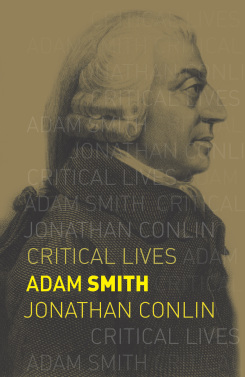Adam Smith
Jonathan Conlin

Universally acknowledged as the father of capitalism, the eighteenth-century Scottish thinker Adam Smith is best known for developing the concept of the ‘invisible hand’. The ‘hand’ helped to explain how the removal of state regulation could set individuals free to specialize and pursue their own interests for the good of all.
Unfortunately this idea was later manipulated by advocates of unfettered casino capitalism, while Smith’s references to self-interest were caricatured as ‘greed is good’, the mantra of Wall Street’s anti-hero Gordon Gekko. Smith’s thought, rooted in the holistic science of moral philosophy, was squeezed into the straitjacket of economics, a discipline unknown in his day.
This introduction to Smith’s thought sews the ‘invisible hand’ back onto the body of Smithian ethics. Smith rooted our trading instinct in human psychology and advanced a system of ethics founded on sympathy.
In life as in books such as the renowned The Wealth of Nations he drew much from the contrasts afforded by the industrializing Scottish Lowlands and the clan-based pastoralism of the Highlands, as well as between contemporaries such as Jean-Jacques Rousseau and David Hume, a close friend. Weaving together his life and ideas, this book highlights the ways in which Smith anticipated recent developments in behavioural economics and virtue ethics as well as debates over inequality. It argues that Smith can equip us to face tomorrow’s challenges and, more importantly, make us better as well as happier humans.
Book Details:
- Author: Jonathan Conlin
- Published Year: 2016
-
Rights Sold
- UK: Reaktion
- China: New World Press

Jonathan Conlin
Jonathan Conlin is a historian of modern Britain with a particular interest in the history of museums and cultural institutions. Born in New York, he studied History and Modern Languages at Oxford, before moving to the Courtauld and then Cambridge for his doctorate. After a research fellowship at Sidney Sussex College, Cambridge and a brief stint at the BBC he moved to the University of Southampton, where he is Professor of Modern History.
In 2024 Jonathan published histories of the Metropolitan Museum of Art and London's National Gallery, the latter commissioned to mark the instit...
More about Jonathan Conlin
Book Reviews
-
"Jonathan Conlin's paperback introduction to Smith is as thorough as it is entertaining. He presents Smith's works, notably "The Theory of Moral Sentiments" (1759) and "The Wealth of Nations" (1776), explaining their theories, concepts and conclusions in a dynamic fashion, without oversimplifying. Conlin brings Smith's world to life. Yet he doesn't only look backwards. On the contrary, in one paragraph Conlin even manages to bring Diogenes the Stoic and Donald Trump together, in a telling exposition of the personal costs Smith associated with the pursuit of wealth."
Frankfurter Allgemeine Zeitung -
"In a well-written and consistently interesting study, Jonathan Conlin shows how Adam Smith, key thinker in the development of economics, is directly relevant not only for the late 18th century but also for today...Conlin deserves congratulations."
Jeremy Black, BBC History Magazine